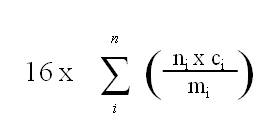Hazardous Products Regulations
Marginal note:Exclusions
7.15.1 (1) An organic peroxide that contains any of the following need not be classified in any category of this hazard class:
(a) not more than 1.0% available oxygen from the organic peroxides when containing not more than 1.0% hydrogen peroxide; or
(b) not more than 0.5% available oxygen from the organic peroxides when containing more than 1.0% but not more than 7.0% hydrogen peroxide.
Marginal note:Available oxygen content
(2) The available oxygen content, in percent, of an organic peroxide mixture referred to in paragraph (1)(a) or (b) is determined by the following formula:

where
- ni
- is the number of peroxygen groups per molecule of organic peroxide i;
- ci
- is the concentration (mass %) of organic peroxide i; and
- mi
- is the molecular mass of organic peroxide i.
Marginal note:Categories
(3) An organic peroxide is classified in a category of this hazard class, based on results from testing performed in accordance with test series A to H of Part II of the Manual of Tests and Criteria, in accordance with the following table:
TABLE
Column 1 Column 2 Item Category Criteria 1 Organic Peroxides — Type A A liquid or solid that, as packaged, is liable to detonate, or deflagrate rapidly 2 Organic Peroxides — Type B A liquid or solid that possesses explosive properties and, as packaged, neither detonates, nor deflagrates rapidly, but is liable to undergo a thermal explosion in that package 3 Organic Peroxides — Type C A liquid or solid that possesses explosive properties and, as packaged, neither detonates, nor deflagrates rapidly, nor undergoes a thermal explosion in that package 4 Organic Peroxides — Type D In laboratory testing, a liquid or solid that
(a) detonates partially, but does not deflagrate rapidly and shows no violent effect when heated under confinement;
(b) does not detonate, but deflagrates slowly and shows no violent effect when heated under confinement; or
(c) neither detonates nor deflagrates, but shows a medium effect when heated under confinement
5 Organic Peroxides — Type E In laboratory testing, a liquid or solid that neither detonates nor deflagrates, and shows low or no effect when heated under confinement 6 Organic Peroxides — Type F In laboratory testing, a liquid or solid that neither detonates in the cavitated state nor deflagrates and
(a) shows low or no effect when heated under confinement, as well as low or no explosive power; or
(b) shows no effect when heated under confinement nor any explosive power, and either
(i) has a SADT < 60°C when evaluated in a 50 kg package, or
(ii) in the case of a liquid mixture, has a diluent that is used for desensitization with a boiling point < 150°C
7 Organic Peroxides — Type G In laboratory testing, a liquid or solid that neither detonates in the cavitated state nor deflagrates, shows no effect when heated under confinement nor any explosive power, and either
(a) has a SADT of 60°C to 75°C when evaluated in a 50 kg package, or
(b) in the case of a liquid mixture, has a diluent that is used for desensitization with a boiling point ≥ 150°C
Marginal note:Mixtures
(4) A mixture of organic peroxides must be classified in the same category as the most hazardous organic peroxide in the mixture, unless the self-accelerating decomposition temperature of the mixture results in the mixture being classified in a category that represents a more severe hazard.
- Date modified: